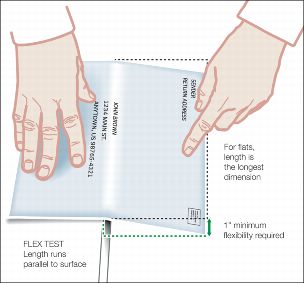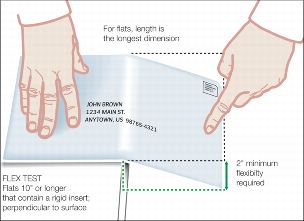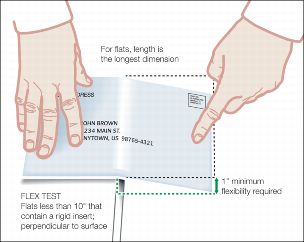- Postcards consist of single cards sent without a wrapper or envelope. Folded (double) cards must be mailed in envelopes at the First-Class Mail International letter price.
- Postcards must be made of cardboard or paper that meets the material and color specifications in 241.4 and 241.5.
See 122.
The postage prices for postcards are as follows:
- Canada: $0.75.
- Mexico: $0.79.
- All other countries: $0.98.
Reply-paid cards are not accepted in international mail, except as provided in 132.2.
Privately manufactured postcards, except picture postcards, must bear the heading Postcard.
Postcards must meet the requirements in 241.5.
Each postcard claimed at a card price must be:
- Rectangular.
- Not less than 3-1/2 inches high or 5-1/2 inches long or 0.007 inch thick.
- Not more than 4-1/4 inches high or 6 inches long or 0.016 inch thick.
Note: Unenclosed cards exceeding the size limits for postcards are mailable at the First-Class Mail International letter price if they do not exceed 4-3/4 inches high or 9-1/4 inches long.
The sender should mark postcards Par Avion or affix Label 19-A, Par Avion Airmail, or Label 19-B, Par Avion Airmail, on the left side on the front.
The right half of the address side of a card must be reserved for the address of the addressee and postal notations or labels.
The sender may use the left half of the address side of the card and the reverse side for a message or permissible attachments. The sender must use the upper-left half of the address side for the return address.
Note: A card without a return address or that is otherwise undeliverable is disposed of in the country of destination.
The following may be glued on the left half of the address side of a card, or on the side opposite the address side, if they are made of paper or other thin material and adhere completely to the card:
- Clippings of any kind.
- Illustrations or photographs.
- Labels other than address labels.
- Stamps of any kind, except stamps likely to be confused with postage stamps, must not be placed on the address side of the card.
- Address labels or address tabs that may be glued to the address side of the card.
A card may not bear an attachment that is:
- Other than paper.
- Not totally adhered to the card surface.
- An encumbrance to postal processing.
The weight limit is 3.5 ounces. (First-Class Mail International letter-size pieces over 3.5 ounces are charged First-Class Mail International flat-size prices.)
Letter-size mail must be rectangular and meet the following dimensions:
- Not less than 5-1/2 inches long or 3-1/2 inches high, or 0.007-inch thick.
- Not more than 11-1/2 inches long or more than 6-1/8 inches high or more than 1/4-inch thick.
Note: For the purpose of determining mailability or machinability of a letter-sized piece: the length is the dimension parallel to the delivery address as read, and the height is the dimension perpendicular to the length.
A $0.20 per-piece surcharge applies to a First-Class Mail International letter, regardless of weight, with one or more of the following nonmachinable characteristics:
- Has an aspect ratio (length divided by height) of less than 1.3 or more than 2.5.
- Is polybagged, polywrapped, or enclosed in any plastic material.
- Have clasps, strings, buttons, or similar closure devices.
- Contains items such as pens, pencils, or loose keys or coins that cause the thickness of the mailpiece to be uneven.
- Is too rigid (does not bend easily when subjected to a transport belt tension of 40 pounds around an 11-inch diameter turn).
- Is more than 4-1/4 inches high or 6 inches long and less than 0.009 inch thick.
- Has a delivery address parallel to the shorter dimension of the mailpiece.
- Is a self-mailer with a final folded edge perpendicular to the address, if the piece is not folded and secured according to DMM 201.3.13.1.
- Is a booklet-type piece with the bound edge (spine) along the shorter dimension of the piece or at the top, unless prepared according to DMM 201.3.13.2.
The weight limit is 4 pounds.
Large envelopes (flats) must meet the following dimensions and characteristics:
- More than 11-1/2 inches long, or more than 6-1/8 inches high or more than 1/4-inch thick.
- Not more than 15 inches long, or more than 12 inches high, or more than 3/4-inch thick.
- Flexible (see 243.33).
- Rectangular.
- Uniformly thick as stated in 243.34.
Note: The length of a large envelope (flat) is the longest dimension. The height is the dimension perpendicular to the length. A First-Class Mail International large envelope (flat) that does not meet the standards in 243.3 is not eligible for large envelope (flat) size price and are charged the applicable package (small packet) price.
Large envelopes (flats) must be flexible. Boxes, with or without hinges, gaps, or breaks that allow the piece to bend, are not considered large envelopes (flats). Tight envelopes or wrappers that are filled with one or more boxes are not considered large envelopes (flats). At the customer's option, a customer may perform the following test on their own mailpieces. When a postal employee observes a customer demonstrating that a flat-size piece is flexible according to these standards, the employee does not need to perform the test. Test flats as follows:
- All large envelopes (flats) (see Exhibit 243.33a):
- Place the piece with the length parallel to the edge of a flat surface and extend the piece halfway off the surface.
- Press down on the piece at a point 1 inch from the outer edge, in the center of the piece's length, exerting steady pressure.
- The piece is not flexible if it cannot bend at least 1 inch vertically without being damaged.
- The piece is flexible if it can bend at least 1 inch vertically without being damaged and it does not contain a rigid insert. No further testing is necessary.
- Test the piece according to 243.33b or 243.33c below if it can bend at least 1 inch vertically without being damaged and it contains a rigid insert.
Exhibit 243.33a
Flexibility Test — All Large Envelopes (Flats)

- Large envelopes 10 inches or longer that pass the test in 243.33a and contain a rigid insert (see Exhibit 243.33b):
- Place the piece with the length perpendicular to the edge of a flat surface and extend the piece 5 inches off the surface.
- Press down on the piece at a point 1 inch from the outer edge, in the center of the piece's width, exerting steady pressure.
- Turn the piece around and repeat steps 1 and 2. The piece is flexible if both ends can bend at least 2 inches vertically without being damaged.
Exhibit 243.33b
Flexibility Test — Large Envelopes (Flats) 10 Inches or Longer

- Large envelopes less than 10 inches long that pass the test in 243.33a and contain a rigid insert (see Exhibit 243.33c):
- Place the piece with the length perpendicular to the edge of a flat surface and extend the piece one-half of its length off the surface.
- Press down on the piece at a point 1 inch from the outer edge, in the center of the piece's width, exerting steady pressure.
- Turn the piece around and repeat steps 1 and 2. The piece is flexible if both ends can bend at least 1 inch vertically without being damaged.
Exhibit 243.33c
Flexibility Test — Large Envelopes (Flats) Less Than 10 Inches Long

Large envelopes (flats) must be uniformly thick so that any bumps, protrusions, or other irregularities do not cause more than 1/4-inch variance in thickness. When determining variance in thickness, exclude the outside edges of a mailpiece (1 inch from each edge) when the contents do not extend into those edges. Also, exclude the selvage of any polywrap covering from this determination. Mailers must secure nonpaper contents to prevent shifting of more than 2 inches within the mailpiece if shifting would cause the piece to be nonuniform in thickness or would result in the contents bursting out of the mailpiece.
The weight limit is 4 pounds.
Packages (small packets) must be within the following dimensions:
- Maximum length: 24 inches. Length is the longest dimension.
- Maximum length, height, and depth (thickness) combined: 36 inches.
- Minimum size: Large enough to accommodate the postage, address, customs form, and other required elements on the address side.
The weight limit is 4 pounds.
Rolls must be within the following dimensions:
- Minimum length: 4 inches.
- Minimum length plus twice the diameter combined: 6-3/4 inches.
- Maximum length: 36 inches.
- Maximum length plus twice the diameter combined: 42 inches.